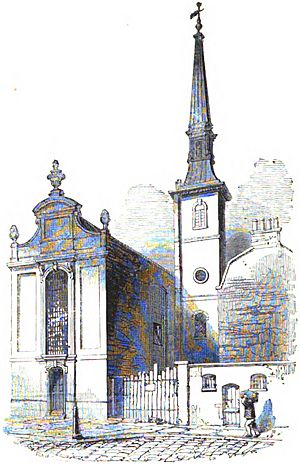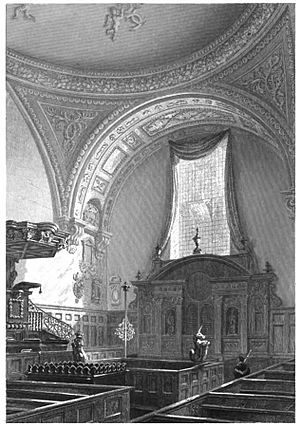St Mildred, Bread Street facts for kids
Quick facts for kids St Mildred, Bread Street |
|
|---|---|
 |
|
| Location | London |
| Country | United Kingdom |
| Denomination | Church of England |
| History | |
| Founded | 1677–83 |
| Architecture | |
| Architect(s) | Christopher Wren |
| Style | Baroque |
The church of St Mildred, Bread Street was a historic church in the City of London. It was named after Saint Mildred the Virgin, a saint from the 7th century. This church had been around since the Middle Ages.
Sadly, it was destroyed in the Great Fire of London in 1666. After the fire, it was rebuilt by the famous architect Sir Christopher Wren. St Mildred's was special because it kept many of Wren's original designs and furniture for a long time. However, it was destroyed again by bombs in 1941 during World War II.
Contents
The Old Church: A Look Back
The first records of St Mildred's church date back to around 1300. It was likely rebuilt then, possibly paid for by Lord Trenchaunt. Another important person, Sir John Shadworth, who was Lord Mayor in 1401, gave the church a house for the priest, a room for church items, and a churchyard.
The church was repaired in 1628. Sir Nicholas Crisp, a rich merchant, helped the church a lot in the 1600s. He gave them two large silver flagons, which were still used hundreds of years later. He also gave a beautiful stained glass window. This window showed important events like the Spanish Armada and the Gunpowder Plot. Sir Nicholas Crisp was buried in the church.
In 1666, the Great Fire of London destroyed St Mildred's. Luckily, the church's silver items were saved. They were taken to safety in a hired carriage. After the fire, the nearby church of St Margaret Moses was not rebuilt. Its parish (area) was then joined with St Mildred's.
Rebuilding with Christopher Wren
The church was rebuilt between 1677 and 1683. Sir Christopher Wren designed the new building. It cost about £3,705. The church was about 62 feet (19 meters) long and 36 feet (11 meters) wide.
The new church did not have side aisles. Instead, the ceiling was a beautiful plastered dome. This dome was decorated with cherubs (angel-like figures), though these were removed later. The front of the church, facing Bread Street, was made of Portland stone. The rest of the church, including its tower, was built with brick. It also had a wooden spire covered in lead.
Important Church Leaders
In the late 1700s, some famous church leaders, called Evangelicals, visited St Mildred's. Two of the most well-known were Thomas Scott and Daniel Wilson. Daniel Wilson later became a bishop in India. Thomas Scott gave talks at the church on Sunday afternoons. Many people came to listen, and his talks helped them a lot.
Later Years and Destruction
On December 30, 1816, the famous poet Percy Bysshe Shelley married Mary Godwin in this church.
In 1898, many old graves were moved from the churchyard to Brookwood Cemetery. Sir Nicholas Crisp's remains were found and moved to be with his heart, which was buried in another town. In 1932, a statue of Arthur Philip was placed on the church wall. He was the first Governor of New South Wales in Australia.
The church was in good condition until it was bombed in 1941. Most of its old records were lost. After the war, the area around St Mildred's church was joined with St Mary-le-Bow, another church.
Between 1973 and 1974, archaeologists dug up the site of the church. They found remains of a Roman building from the 1st century underneath the church. Today, an office building stands where the church once was.
Images for kids



